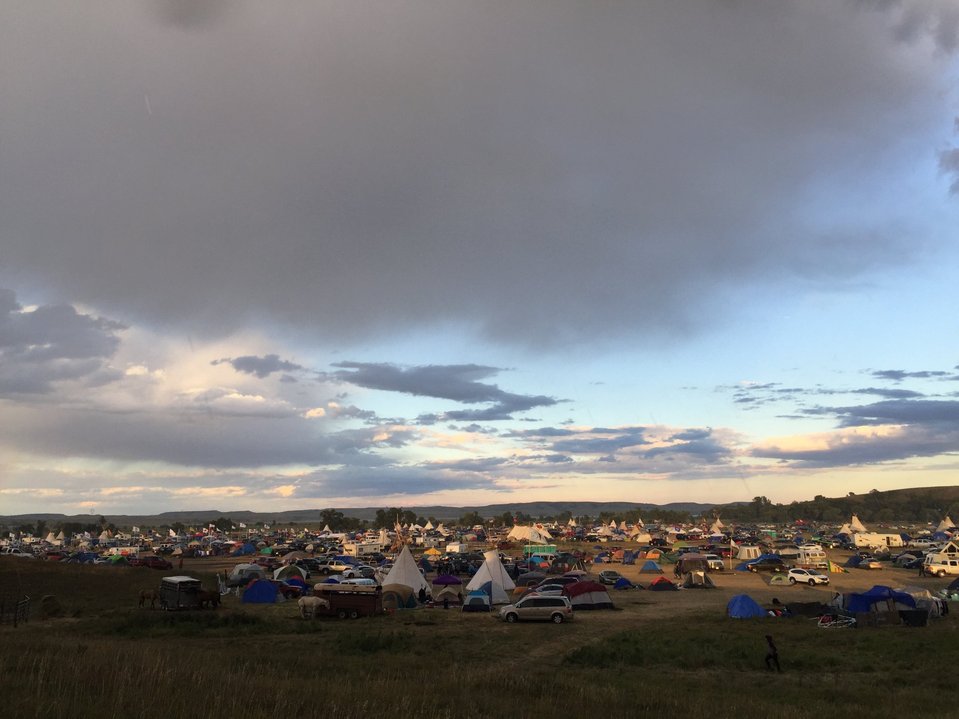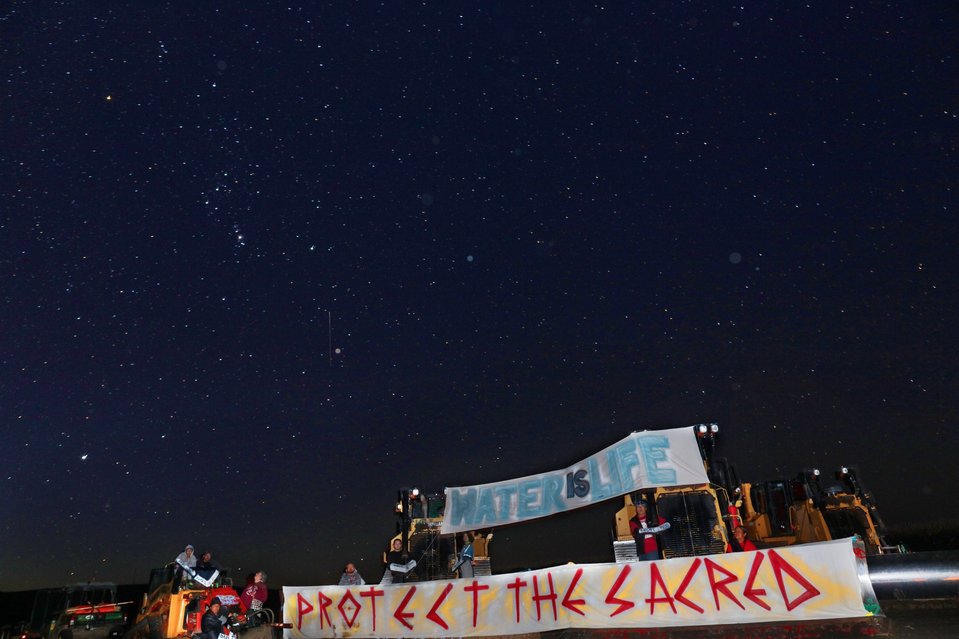Still Native Land: Understanding the Movement at Standing Rock
The land being protected at Standing Rock Sioux holds the resting bones of the Sioux, Hidatsa, Mandan, Lakota, Nakota and Dakota people. Wherever our bones rest, our ceremonies live. Our histories and stories are intertwined with our identity, and to us, our native identity is inextricably connected to land. The idea of digging up our ancestors bones for fossil fuel’s dying industry is an utter, shameful disgrace. It’s hard to describe how outrageous such desecration is to people who have lost their own connections to their ancient histories, or to those that don’t feel the vitality, abundance and wonder of land.
I’ve heard cyber bullies argue, “Indians think everything is sacred, and it’s not that big of a deal, it was a long time ago that people were buried there”; I’ve read your comments, to “get over it”, to “move on”, and that “you all drive cars too, so you should want oil prices to go down”; I’ve heard you say that pipelines “are the safest form of crude oil transportation”.
But I’d like to ask you put it into context.
Think of the most recent death you’ve grieved- be it, sadly, your Mom, your Grandpa, or your best friend, and then imagine the sight of their remains being dug up for the profit of men that wear fancy suits and drive Bentleys.
But it’s not just that.
Imagine if it was being done to you as continuation of dominance and exploitation that had already taken everything you have. Imagine if the people doing the digging were part of a ruthless economic and legal system that had already forced your grandparents to move off their land to desolate spaces called “reservations”- forcing you to abandon your language for their colonized tongue, and then punished you for your religious beliefs and cultural ways. Imagine if they tried to force a new God on you, stripped away your humanity and denied you civil liberties, promised you the right to self governance and that your children would have education, and a better, “civilized” life … and what if all those promises were empty? What if you had gone to fifty funerals of relatives and friends last year? What if half of your kids were dropping out of high school? What if you had four sisters, and three of them had been raped? What if your brother, and uncle were in jail, or fresh out of jail. What if you lived in a suffering community that was attempting to recover from the most heartless, genocidal racist government policies to wipe you out or subordinate you, and then, those same people wanted to dig up your grandparents’ bones.
Would you let them?
Last weekend, the private land owner of a section of proposed DAPL construction came to the Standing Rock Sioux Tribe and confessed that he’d found human remains in what would be the pathway of the pipeline. The tribe immediately filed a request for the Tribal Historic Preservation Office to do a survey, and notified the courts. It was Friday, September 2, just before the Labor Day holiday weekend. The courts would re-open on Tuesday. DAPL’s operatives discovered the filed survey, and in an erratic, desperate state, decided to go fifteen miles away from their current working path, on a Saturday when they normally are idle, to dig up and thus destroy the critically important area that was supposed to be surveyed the next work week. Water protectors, mostly women, went to that site on Saturday, to pray for the found remains, and encountered DAPL digging up what was assumed to be an ancestral burial site. It was mayhem. DAPL hired private security armed with pepper spray and dogs. We released a film detailing the events:
Hired DAPL Security Officers Violently Attack Native Americans with Dogs and Pepper Spray
Every time I watch this film I think of Selma. I wish I had words to describe the experience. I’ve never seen anything like it before. Watching the day escalate was terrifying.
The next day, thousands came to Standing Rock to march to the disturbed site to pray, once we arrived to the site, we all stood in a giant circle, and the Sundance chiefs offered prayers. It felt necessary.
Protectors Of The Sacred
Since then, there have been some major changes. September 9th was decision day for the federal court. On that day, Sacred Stone Camp requested that we go to North Dakota’s Capitol for song and prayer. As we left the camp, rain came with all of its mid-western force. It was like a tropical monsoon, sweeping the prairie with the water’s blessings to prepare ourselves for what the day had in store. Over the radio we heard the decision. The federal judge denied the request for a preliminary injunction, stating that the permit process for the pipeline had allowed all parties, including the tribe, adequate participation, “the opportunity to be heard” under existing standards for approval.
I couldn’t believe it.
We rode in silence.
I looked out at the prairie, remembering that this was all Indian land and tried to imagine the eighty-five species of grass that used to exist here prior to Anglo agricultural dominance, and how it will never be the same. I tried to imagine buffalo roaming free instead of cows enslaved to GMO pastures. Salty tears blurred my vision. I felt as if I had been stabbed in my stomach; the outcome was yet another violation by the powers that for centuries have disregarded and eviscerated what matters to our Native people.
We decided that we needed “pezuta sapa”, “black medicine”, before heading to the capitol. We sat in the coffee shop, barely able to speak. How is it possible that a man, a federal judge, on the other side of Turtle Island is able to decide the fate of our people? How does it make any sense?
Then, within moments, something so unexpected and amazing happened. President Obama finally acted: through the Department of Justice, the Department of the Army and the Department of the Interior , DAPL was made to back off of Standing Rock’s territory. The statement from the federal government declared that, “ … [T]his case has highlighted the need for a serious discussion on whether there should be nationwide reform with respect to considering tribes’ views on these types of infrastructure projects.” And specifically noting the peaceful and legitimate activities of the protectors against this horribly conceived project, the statement concludes, “ It is now incumbent on all of us to develop a path forward that serves the broadest public interest.”
What the President has done is game-changing. The review process for DAPL and other such infrastructural projects must be re-considered: when a sovereign Native nation may be impacted by an energy/infrastructural company using federal laws to meet its aims, far greater deference, respect, and accommodation of that nation’s superior interests are required by the United States to allow private intrusion and impacts upon that sovereignty. The existing standards, which trivialize Native power, are now themselves inadequate. Energy Partners and their lawyers could have been proactive and listened to the good sense being offered them by the protectors, much of it in accord with the President’s approach.
We arrived at the capitol and people celebrated with war hoops and round dances. It was such a beautiful celebratory moment.
I arrived back to camp that night and walked from fireplace to fireplace: California Natives offered bird songs with clap sticks and dancing jubilance, Haudenosaunee’s sang with water drums in their ancient language, Nakota’s sang heart throbbing Sundance songs, Shinnecock’s offered round dance songs, there was a NorthWest-Coastal-jam, a comedy show, a hip hop show, there were even people playing reggae. It was a night that I’ll never forget. I heard an auntie say that Standing Rock has now become a place where she feels the freedom to be an Indian. I felt it too. I felt proud to be an Indian that night.
Sadly, DAPL has chosen to continue construction despite the hierarchal advice. Yesterday 30 people were arrested for protecting the water. This fight will continue because this land matters to our people, and Standing Rock represents the confluence environmental and civil justice for all Native people. What happens to the land, happens to us, and right now, we are in the moment of deciding that what happened in the past, cannot happen in the future.









